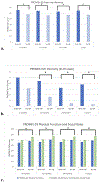Neuropathic Pain After Burn Injury: A Severe and Common Problem in Recovery
- PMID: 37916448
- PMCID: PMC10997473
- DOI: 10.1097/SLA.0000000000006146
Neuropathic Pain After Burn Injury: A Severe and Common Problem in Recovery
Abstract
Objective: The aim of this study was to address the limited understanding of neuropathic pain (NP) among burn survivors by comprehensively examining its prevalence and related factors on a national scale using the Burn Model System (BMS) National Database.
Background: NP is a common but underexplored complaint among burn survivors, greatly affecting their quality of life and functionality well beyond the initial injury. Existing data on NP and its consequences in burn survivors are limited to select single-institution studies, lacking a comprehensive national perspective.
Methods: The BMS National Database was queried to identify burn patients responding to NP-related questions at enrollment, 6 months, 12 months, 2 years, and 5 years postinjury. Descriptive statistics and regression analyses were used to explore associations between demographic/clinical characteristics and self-reported NP at different time points.
Results: There were 915 patients included for analysis. At discharge, 66.5% of patients experienced NP in their burn scars. Those with NP had significantly higher Patient-Reported Outcomes Measurement Information System 29 (PROMIS-29) pain inference, itch, anxiety, depression, and sleep disturbance scores and were less able to partake in social roles. Multiple logistic regression revealed male sex, % total body surface area, and moderate-to-severe pain as predictors of NP at 6 months. At 12 months, % total body surface area and moderate-to-severe pain remained significant predictors, while ethnicity and employment status emerged as significant predictors at 24 months.
Conclusions: This study highlights the significant prevalence of NP in burn patients and its adverse impacts on their physical, psychological, and social well-being. The findings underscore the necessity of a comprehensive approach to NP treatment, addressing both physical symptoms and psychosocial factors.
Copyright © 2023 Wolters Kluwer Health, Inc. All rights reserved.
Conflict of interest statement
The authors report no conflicts of interest.
Figures


Similar articles
-
Analysis of the predictors of hypertrophic scarring pain and neuropathic pain after burn.Burns. 2022 Sep;48(6):1425-1434. doi: 10.1016/j.burns.2021.08.007. Epub 2021 Aug 15. Burns. 2022. PMID: 34670714
-
The Presence of Scarring and Associated Morbidity in the Burn Model System National Database.Ann Plast Surg. 2019 Mar;82(3 Suppl 2):S162-S168. doi: 10.1097/SAP.0000000000001826. Ann Plast Surg. 2019. PMID: 30724824 Free PMC article.
-
Predictors at 6 and 12 Months for Social Participation Outcome at 24 Months in the Adult Burn Injury Population: A Burn Model System National Database Study.Arch Phys Med Rehabil. 2024 Feb;105(2):235-242. doi: 10.1016/j.apmr.2023.06.011. Epub 2023 Jun 30. Arch Phys Med Rehabil. 2024. PMID: 37392780 Free PMC article.
-
Psychopathology and psychological problems in patients with burn scars: epidemiology and management.Am J Clin Dermatol. 2003;4(4):245-72. doi: 10.2165/00128071-200304040-00004. Am J Clin Dermatol. 2003. PMID: 12680803 Review.
-
[Systematic review of physical and psychosocial problems of burned children aged 5 years and below after discharge].Zhonghua Shao Shang Za Zhi. 2019 May 20;35(5):371-378. doi: 10.3760/cma.j.issn.1009-2587.2019.05.009. Zhonghua Shao Shang Za Zhi. 2019. PMID: 31154736 Chinese.
Cited by
-
Exosomes: A Promising Cell-Free Therapeutic Tool for Treating Cutaneous Nerve Injuries and Promoting Wound Healing.Int J Mol Sci. 2025 Jun 1;26(11):5323. doi: 10.3390/ijms26115323. Int J Mol Sci. 2025. PMID: 40508132 Free PMC article. Review.
References
-
- Shu F, Liu H, Lou X, et al. Analysis of the predictors of hypertrophic scarring pain and neuropathic pain after burn. Burns. 2022;48(6):1425–1434. - PubMed
MeSH terms
Grants and funding
LinkOut - more resources
Full Text Sources
Medical
Research Materials
Miscellaneous

